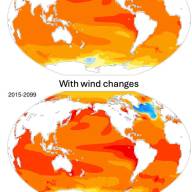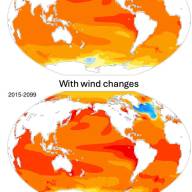THE LATEST
AI joins the fight to save the Amazon: Leicester scientists pioneer tech-driven conservation
Tuesday, 10 June 2025 19:09  In a groundbreaking development that blends tradition with technology, scientists at the University of Leicester are harnessing artificial intelligence to help safeguard one of the most critical...
In a groundbreaking development that blends tradition with technology, scientists at the University of Leicester are harnessing artificial intelligence to help safeguard one of the most critical...
Supercomputers illuminate the North Atlantic's climate enigma
Thursday, 05 June 2025 19:59  In the vast expanse between Greenland and Ireland lies a curious climatic anomaly: the North Atlantic warming hole. Contrary to its name, this region is experiencing a relative cooling trend amidst...
In the vast expanse between Greenland and Ireland lies a curious climatic anomaly: the North Atlantic warming hole. Contrary to its name, this region is experiencing a relative cooling trend amidst...
AI illuminates the cosmos: Vanderbilt scientists uncover hidden black holes
Wednesday, 04 June 2025 19:35  In a remarkable fusion of astrophysics and artificial intelligence, researchers at Vanderbilt University have unveiled compelling evidence for the existence of intermediate-mass black holes...
In a remarkable fusion of astrophysics and artificial intelligence, researchers at Vanderbilt University have unveiled compelling evidence for the existence of intermediate-mass black holes...
LATEST NEWS
AI joins the fight to save the Amazon: Leicester scientists pioneer tech-driven conservation
Tuesday, 10 June 2025 19:09  In a groundbreaking development that blends tradition with technology, scientists at the University of Leicester are harnessing artificial intelligence to help safeguard one of the most critical...
In a groundbreaking development that blends tradition with technology, scientists at the University of Leicester are harnessing artificial intelligence to help safeguard one of the most critical...
Supercomputers illuminate the North Atlantic's climate enigma
Thursday, 05 June 2025 19:59  In the vast expanse between Greenland and Ireland lies a curious climatic anomaly: the North Atlantic warming hole. Contrary to its name, this region is experiencing a relative cooling trend amidst...
In the vast expanse between Greenland and Ireland lies a curious climatic anomaly: the North Atlantic warming hole. Contrary to its name, this region is experiencing a relative cooling trend amidst...
AI illuminates the cosmos: Vanderbilt scientists uncover hidden black holes
Wednesday, 04 June 2025 19:35  In a remarkable fusion of astrophysics and artificial intelligence, researchers at Vanderbilt University have unveiled compelling evidence for the existence of intermediate-mass black holes...
In a remarkable fusion of astrophysics and artificial intelligence, researchers at Vanderbilt University have unveiled compelling evidence for the existence of intermediate-mass black holes...
POPULAR
- UVA unveils the power of AI in accelerating new treatment discoveries
- AI meets DNA: Scientists create custom gene editors with machine learning
- New study tracks pollution worldwide
- Darkening oceans: New study reveals alarming decline in marine light zones
- Intel's recent developments highlight the company's ongoing struggles amid leadership changes, financial difficulties
- Woolpert, Teren leverage geospatial tech for global energy solutions
- Hospital del Mar explores novel pathways in drug development
- AI model predicts multi-resistance in bacteria: Unveiling the power of big data
- Tulane researchers use AI to improve diagnosis of drug-resistant infections
- Unraveling the mystery of intermediate-mass black holes: A Chinese perspective
THIS YEAR'S MOST READ
- A new method for modeling complex biological systems: Is it a real breakthrough or hype?
- Woolpert welcomes Amar Nayegandhi as the Global Head of Technology and Innovation
- A new medical AI tool has revealed previously unrecognized cases of long COVID by analyzing patient health records
- New supercomputer models show intensifying wildfires in a warming world
- UVA unveils the power of AI in accelerating new treatment discoveries
- USC shows a more accurate picture of brain aging
- Woolpert strengthens global technological expertise with Carl Lucas as CIO
- Retired U.S. Army Maj. Gen. Tom Tickner joins Woolpert to provide support for federal clients, projects
- Groundbreaking AI discovery reveals over 160,000 new virus species
- AI meets DNA: Scientists create custom gene editors with machine learning
MOST READ OF ALL-TIME
- Largest Computational Biology Simulation Mimics The Ribosome
- Silicon 'neurons' may add a new dimension to chips
- Complex Concepts That Really Add Up
- Linux Networx Accelerators Expected to Drive up to 4x Price/Performance
- Blue Sky Studios Donates Animation SuperComputer to Wesleyan
- Humanities, HPC connect at NERSC
- TeraGrid ’09 'Call for Participation'
- Turbulence responsible for black holes' balancing act
- Cray Wins $52 Million SuperComputer Contract
- SDSC Researchers Accurately Predict Protein Docking
POPULAR
- UVA unveils the power of AI in accelerating new treatment discoveries
- AI meets DNA: Scientists create custom gene editors with machine learning
- New study tracks pollution worldwide
- Darkening oceans: New study reveals alarming decline in marine light zones
- Intel's recent developments highlight the company's ongoing struggles amid leadership changes, financial difficulties
